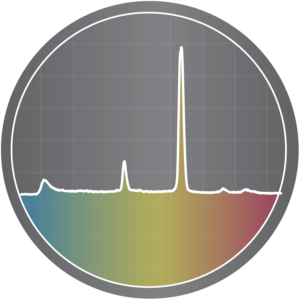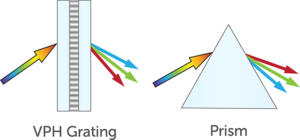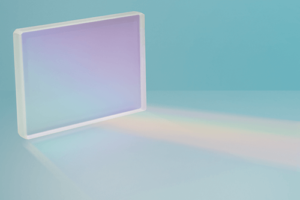 Optical spectroscopy is the science of studying physical objects on the basis of light-matter interactions. Carrying out optical spectroscopy begins with recording spectral data, whether absorption, transmission, reflection, emission, or through more complex interactions such as Raman scattering
Optical spectroscopy is the science of studying physical objects on the basis of light-matter interactions. Carrying out optical spectroscopy begins with recording spectral data, whether absorption, transmission, reflection, emission, or through more complex interactions such as Raman scattering
Spectrometry represents all experimental methods that collect and investigate spectra. A foundational requirement for spectrometry in the optical regime is the dispersion of light into the wavelengths you want to study. Spectroscopy gratings are ideal optical dispersing elements for spectrometric measurements.
How to Separate Light into its Constituent Wavelengths
Light as an electromagnetic wave experiences dispersion when its velocity or direction depends on its wavelength. Most spectroscopy instruments make use of angular dispersion: in this case, light that passes through a dispersive element has an output beam angle that changes with the wavelength. For example, a white light beam would be split into its all visible color components in a rainbow-like matter by a dispersive element.
 The most common types of dispersive elements are prisms and gratings. The major difference between those two elements is that dispersion of a prism is non-linear while gratings offer linear dispersion. Spectroscopy gratings can spread light linearly and equally. That is determined by the fact that the basic principle for dispersion is different. A prism disperses light via refraction while gratings disperse light into different directions through diffraction. In spectroscopy applications, the individual wavelengths are detected for spectroscopic analysis after the dispersion of light from the sample.
The most common types of dispersive elements are prisms and gratings. The major difference between those two elements is that dispersion of a prism is non-linear while gratings offer linear dispersion. Spectroscopy gratings can spread light linearly and equally. That is determined by the fact that the basic principle for dispersion is different. A prism disperses light via refraction while gratings disperse light into different directions through diffraction. In spectroscopy applications, the individual wavelengths are detected for spectroscopic analysis after the dispersion of light from the sample.
Spectroscopy gratings are optical elements of a periodic and equally spaced structure. The fundamental physical process behind this is the division of the incident radiation wavefronts by the periodic structure, followed by constructive and destructive interference that eventually leads to light dispersion. Thus, each wavelength incident upon a spectroscopy grating leaves the grating at a slightly different angle. Spectroscopy gratings may operate either in reflection or transmission. The dispersion in both types depends on the spacing of adjacent elements in the periodic structure, also expressed as line or groove density. A greater number of lines or grooves per millimeter results in more dispersion or separation of wavelengths. This in combination with the distance between the grating and detector and spatial intervals at which the spectrum is measured determines the resolution of the collected spectrum.
Optical Properties for Spectroscopy
Spectroscopy gratings that fulfill certain optical characteristics show better suitability for spectroscopy applications than others. Beneficial features for spectroscopy gratings amongst others are high diffraction efficiencies over a broad spectral range, low scatter and ghosting for less stray light, high line densities for high resolution spectroscopy and low polarization sensitivity. All those characteristics are especially important for low light applications such as Raman and fluorescence spectroscopy.
 At Wasatch Photonics, we produce volume phase holographic (VPH) transmission gratings that offer all of the key advantages required for successful use as spectroscopy gratings. VPH gratings consist of periodic structures of high and low index of refraction imaged in dichromated gelatin, hermetically sealed between two optical windows. Use of a transmission grating allows a more compact, stable optical design than would be possible using a conventional reflection grating. VPH gratings are also very robust and as easy to clean as any other glass optical component. The size and substrate type are highly customizable. All these features make VPH gratings from Wasatch Photonics highly suitable as spectroscopy gratings for a wide range of applications, particularly when low light level detection is required. Please contact us to discuss your unique needs today!
At Wasatch Photonics, we produce volume phase holographic (VPH) transmission gratings that offer all of the key advantages required for successful use as spectroscopy gratings. VPH gratings consist of periodic structures of high and low index of refraction imaged in dichromated gelatin, hermetically sealed between two optical windows. Use of a transmission grating allows a more compact, stable optical design than would be possible using a conventional reflection grating. VPH gratings are also very robust and as easy to clean as any other glass optical component. The size and substrate type are highly customizable. All these features make VPH gratings from Wasatch Photonics highly suitable as spectroscopy gratings for a wide range of applications, particularly when low light level detection is required. Please contact us to discuss your unique needs today!


